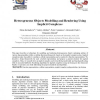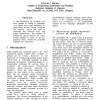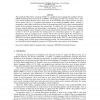96 search results - page 6 / 20 » The role of secondary attributes in formal object modelling |
89
Voted
IV
2005
IEEE
15 years 5 months ago
2005
IEEE
This paper describes a technology for modelling and rendering heterogeneous objects containing entities of various dimensionalities within a cellular-functional framework based on...
LOPSTR
1999
Springer
15 years 3 months ago
1999
Springer
Abstract. A formal and effective approach to the extension of the computational behaviour of logic programs is presented. The approach builds upon the following concepts. The exte...
IJCAI
1989
15 years 24 days ago
1989
A new formalism for building network models in Prolog is proposed. It is based on a new semantic interpretation of the Prolog variables and clauses, which are used to represent th...
115
Voted
IJCSA
2008
14 years 11 months ago
2008
The Graphical Object Query Language (GOQL) is a graphical query language that complies with the ODMG standard and runs on top of the o2 DBMS. The language provides users with the ...
117
click to vote
CODES
2006
IEEE
15 years 5 months ago
2006
IEEE
Embedded system optimization typically considers objectives such as cost, timing, buffer sizes and power consumption. Robustness criteria, i.e. sensitivity of the system to variat...



